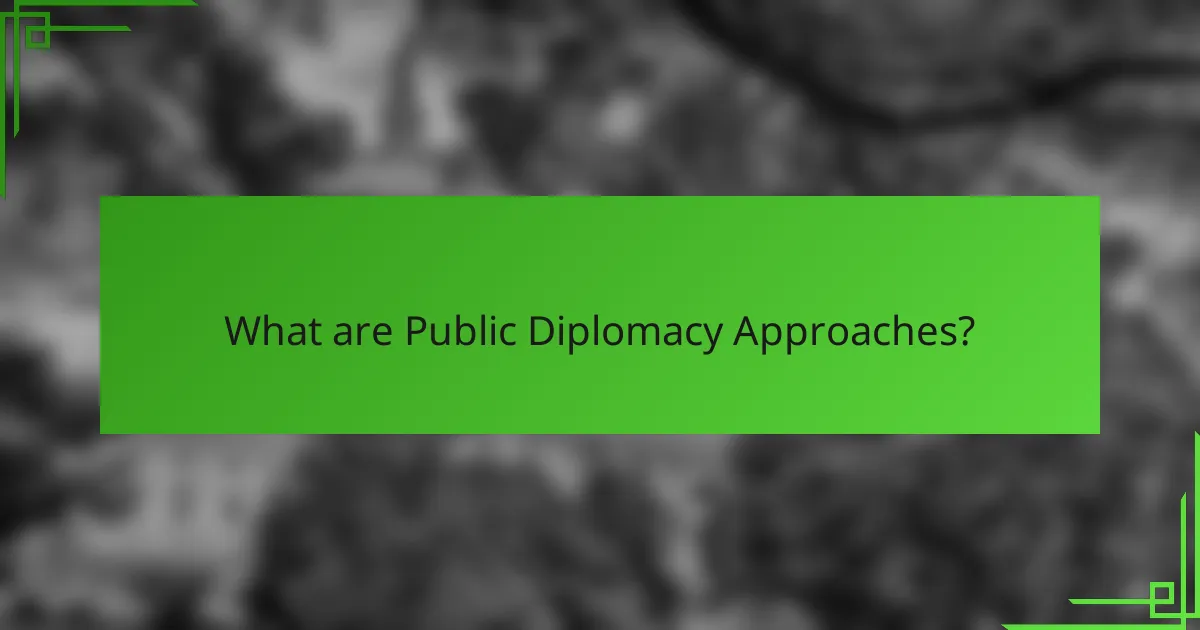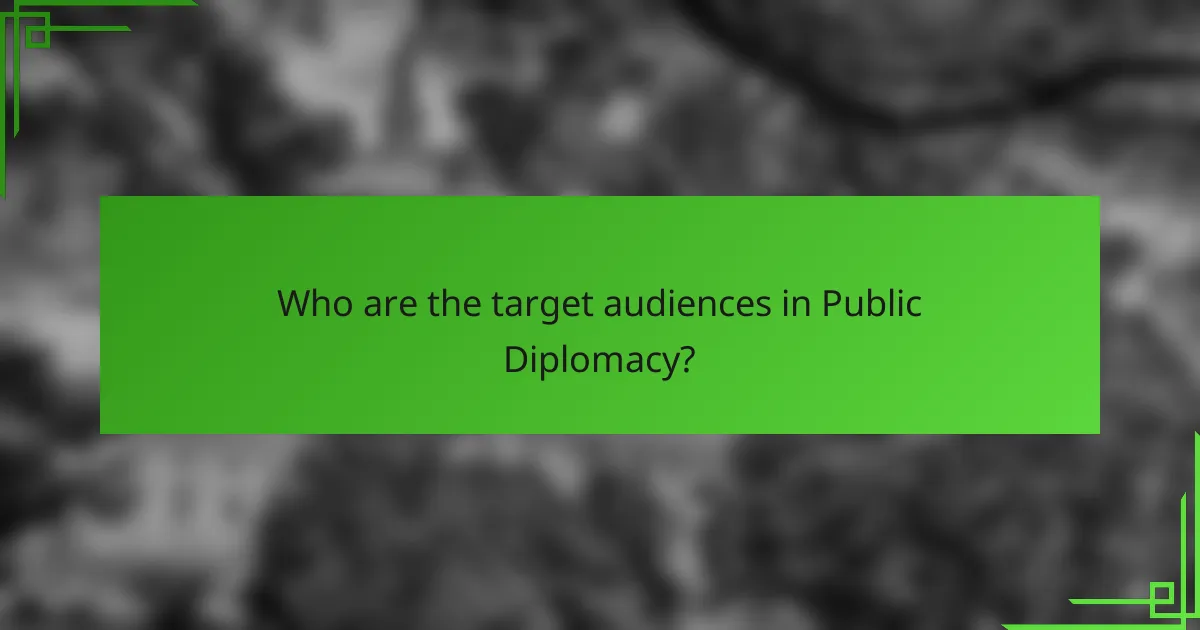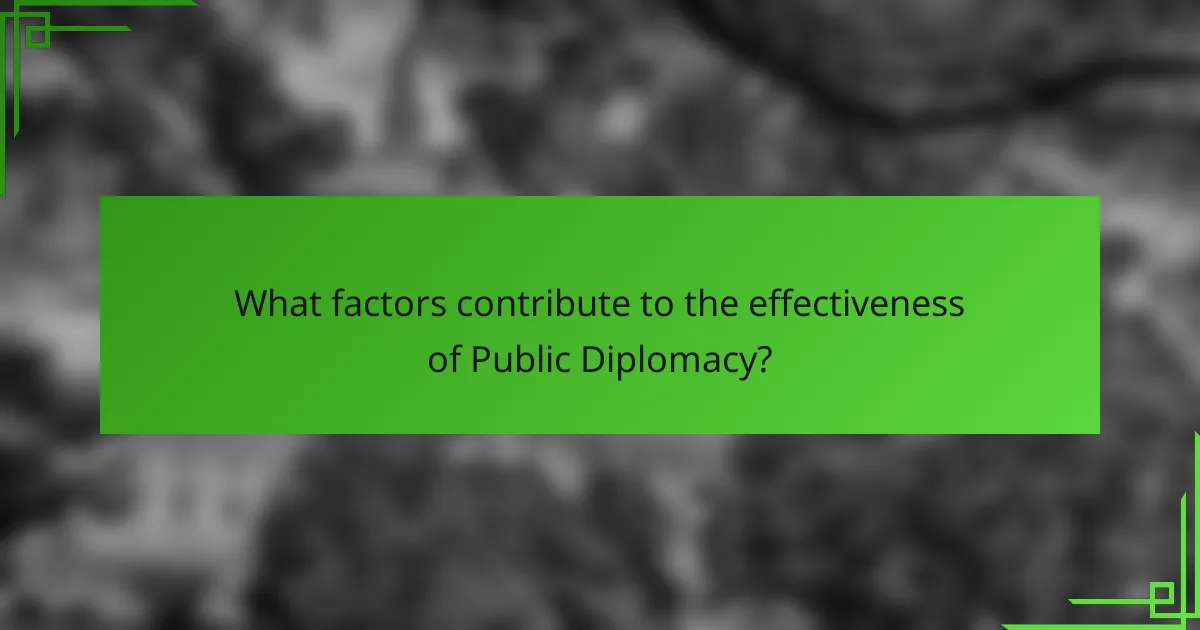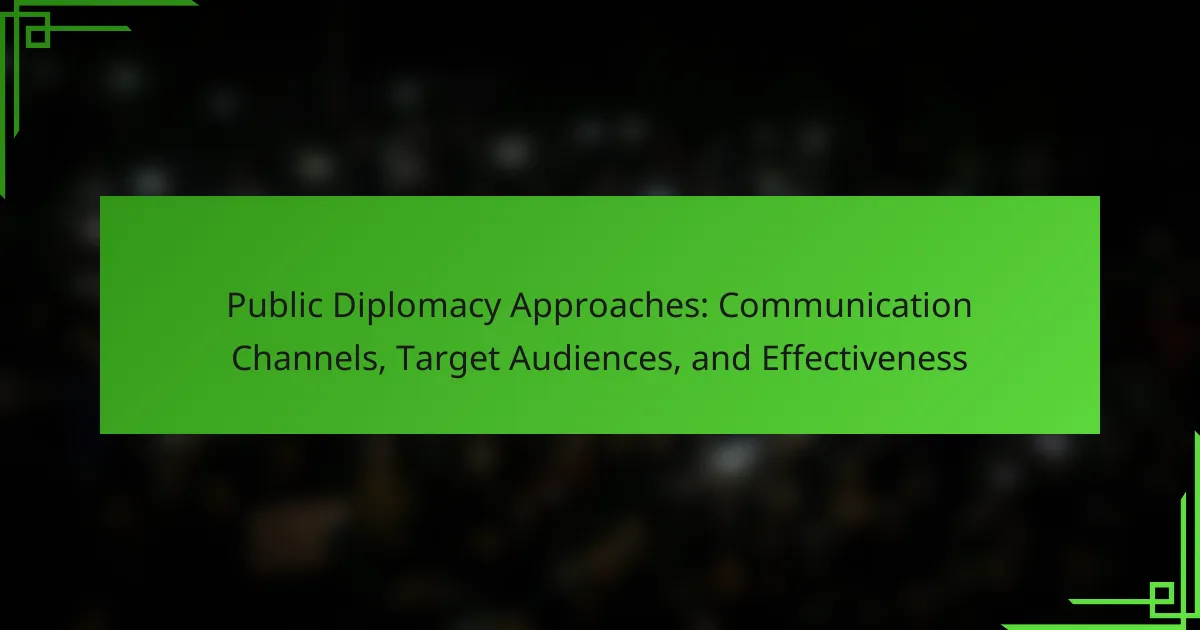Public diplomacy approaches are strategies employed by governments to engage foreign publics, aiming to influence public opinion and foster mutual understanding. These approaches include cultural exchanges, international broadcasting, and social media campaigns, each targeting specific audiences such as foreign governments, international organizations, and civil society groups. The effectiveness of public diplomacy is determined by factors such as message clarity, cultural understanding, and source credibility, along with the use of diverse communication channels. Engaging these audiences enhances relationships and promotes positive international cooperation, making public diplomacy a vital component of global relations.

What are Public Diplomacy Approaches?
Public diplomacy approaches are strategies used by governments to engage with foreign publics. These approaches aim to influence public opinion and foster mutual understanding. Common methods include cultural exchanges, international broadcasting, and social media campaigns. Each approach targets specific audiences to enhance a nation’s image abroad. For example, cultural diplomacy promotes national culture through arts and education. This method builds relationships and fosters goodwill. Research shows that effective public diplomacy can lead to improved international relations and cooperation.
How do Public Diplomacy Approaches differ from traditional diplomacy?
Public diplomacy approaches differ from traditional diplomacy primarily in their focus and methods. Traditional diplomacy emphasizes formal negotiations between government representatives. It relies on official channels and state-to-state interactions. Public diplomacy, in contrast, engages with foreign publics directly. It aims to influence public opinion and foster mutual understanding.
Public diplomacy utilizes various communication channels, including media, cultural exchanges, and social platforms. This approach seeks to build relationships beyond government entities. Traditional diplomacy often operates behind closed doors and is less transparent. Public diplomacy encourages open dialogue and participation from non-state actors.
Historical examples highlight these differences. The United States’ use of cultural programs during the Cold War exemplifies public diplomacy’s impact. This approach aimed to counter Soviet influence by promoting American values. In summary, public diplomacy is broader and more inclusive than traditional diplomacy.
What are the key characteristics of Public Diplomacy Approaches?
Public diplomacy approaches are characterized by their focus on engaging foreign publics. They utilize communication channels to foster mutual understanding. These approaches aim to influence public opinion and shape perceptions. They often involve cultural exchanges and educational initiatives. Public diplomacy is distinct from traditional diplomacy, as it emphasizes grassroots engagement. Effectiveness is measured through audience reach and impact on international relations. Historical examples include the U.S. Information Agency’s initiatives during the Cold War. These characteristics highlight the strategic role of public diplomacy in global affairs.
How do cultural and political contexts influence Public Diplomacy Approaches?
Cultural and political contexts significantly shape public diplomacy approaches. These contexts determine how messages are crafted and received. Cultural values influence the symbols and narratives used in communication. For instance, collectivist societies may prioritize community over individualism in diplomatic messaging. Political environments dictate the level of openness and trust in communication. Authoritarian regimes may restrict information flow, impacting transparency. Historical relationships between nations also play a role. Countries with a history of conflict may adopt more cautious or defensive diplomatic strategies. Conversely, nations with strong alliances may engage in more collaborative approaches. Overall, understanding these contexts is crucial for effective public diplomacy.
What role do communication channels play in Public Diplomacy?
Communication channels are essential in public diplomacy as they facilitate the exchange of information between nations and their audiences. They help shape perceptions and foster relationships through strategic messaging. Effective communication channels include social media, traditional media, and direct diplomacy. Each channel serves a unique purpose in reaching diverse target audiences. For instance, social media allows for real-time engagement and broader reach. Traditional media provides credibility and context to messages. Direct diplomacy enables personal connections and nuanced discussions. The choice of communication channel can significantly impact the effectiveness of public diplomacy efforts. Studies show that successful public diplomacy often relies on a combination of these channels to achieve its objectives.
Which communication channels are most effective in Public Diplomacy?
The most effective communication channels in public diplomacy are social media, traditional media, and direct engagement. Social media platforms like Twitter and Facebook allow for real-time interaction and broad outreach. Traditional media, including television and newspapers, provide credibility and reach to diverse audiences. Direct engagement through cultural exchanges and diplomatic visits fosters personal connections. Research indicates that these channels enhance message dissemination and audience engagement. For instance, a study by the U.S. Advisory Commission on Public Diplomacy shows that social media significantly increases public awareness and engagement in diplomatic efforts.
How do digital platforms enhance Public Diplomacy efforts?
Digital platforms enhance Public Diplomacy efforts by facilitating real-time communication and engagement with global audiences. They enable governments and organizations to share information quickly and effectively. Social media platforms allow for direct interaction with citizens, fostering dialogue and understanding. Digital tools also provide analytics that help measure public sentiment and engagement levels. For instance, the U.S. State Department uses platforms like Twitter and Facebook to communicate policies and respond to inquiries. This approach increases transparency and builds trust. Furthermore, digital platforms allow for targeted outreach to specific demographics, maximizing the effectiveness of messaging. Studies have shown that digital engagement can significantly improve public perception and international relations.

Who are the target audiences in Public Diplomacy?
The target audiences in public diplomacy include foreign governments, international organizations, and foreign publics. Foreign governments are key stakeholders as they shape diplomatic relations. International organizations, such as the United Nations, facilitate multilateral dialogue. Foreign publics, including citizens and civil society groups, influence public opinion and policy. Additionally, media outlets play a crucial role in disseminating information. Academic institutions and think tanks are also targeted for their expertise and influence. Engaging these audiences enhances mutual understanding and fosters positive relationships.
What factors determine the selection of target audiences in Public Diplomacy?
The selection of target audiences in Public Diplomacy is determined by several key factors. These factors include geopolitical interests, cultural relevance, and demographic characteristics. Geopolitical interests focus on nations or groups that align with a country’s strategic goals. Cultural relevance emphasizes shared values and beliefs that facilitate communication. Demographic characteristics involve age, education, and socio-economic status, which affect receptiveness to diplomatic messages. Additionally, historical relationships with target audiences can influence selection. Research indicates that effective Public Diplomacy considers these factors to enhance engagement and impact.
How do demographics influence the effectiveness of Public Diplomacy strategies?
Demographics significantly influence the effectiveness of Public Diplomacy strategies. Different demographic groups respond variably to communication styles and content. Age, gender, education level, and cultural background shape perceptions and engagement. For instance, younger audiences may prefer digital platforms, while older demographics favor traditional media.
Research indicates that tailored messaging increases resonance with specific demographic groups. A study by the U.S. Advisory Commission on Public Diplomacy found that culturally relevant content enhances audience engagement. Moreover, language proficiency affects comprehension and acceptance of diplomatic messages.
Targeting specific demographics allows for more effective allocation of resources. By understanding demographic preferences, diplomats can optimize strategies for better outreach. This leads to increased trust and credibility in international relations.
What are the challenges in engaging diverse audiences in Public Diplomacy?
Engaging diverse audiences in Public Diplomacy poses several challenges. Cultural differences can lead to misunderstandings of messages. Language barriers may hinder effective communication and connection. Varied political contexts influence audience receptiveness to diplomatic efforts. Different media consumption habits affect how information is received. Additionally, audience fragmentation complicates targeting and messaging strategies. Research shows that tailored approaches are necessary for effective engagement. A study by the U.S. Institute of Peace highlights the importance of cultural competence in diplomacy. These challenges necessitate adaptive strategies for successful public diplomacy initiatives.
How do different audiences respond to Public Diplomacy initiatives?
Different audiences respond to Public Diplomacy initiatives in varied ways based on their cultural, social, and political contexts. For instance, youth audiences often engage with digital campaigns more actively than older demographics. Research shows that younger individuals prioritize social media interactions, leading to greater awareness and participation in initiatives. In contrast, older audiences may respond better to traditional media approaches, such as television and print.
Additionally, audiences in democratic societies might express more favorable responses due to values of openness and engagement. In contrast, audiences in authoritarian regimes may exhibit skepticism or indifference due to government control over information. Studies indicate that local cultural values significantly influence the effectiveness of Public Diplomacy efforts. Tailoring messages to align with these values enhances receptivity and engagement.
In summary, audience demographics and sociopolitical environments play crucial roles in shaping responses to Public Diplomacy initiatives.
What methods are used to measure audience engagement in Public Diplomacy?
Methods to measure audience engagement in Public Diplomacy include surveys, social media analytics, and focus groups. Surveys gather quantitative data on audience perceptions and attitudes. Social media analytics track interactions, shares, and comments to gauge interest and reach. Focus groups provide qualitative insights through discussions with selected audience members. These methods help assess the effectiveness of public diplomacy initiatives. They enable diplomats to adjust strategies based on audience feedback and engagement levels.
How can feedback from target audiences improve Public Diplomacy approaches?
Feedback from target audiences can significantly enhance Public Diplomacy approaches. It allows diplomats to understand the perceptions and needs of the audience. This understanding can lead to more tailored and effective messaging. For instance, surveys and focus groups can reveal audience preferences. Data from these tools can guide content creation and communication strategies. Historical examples show that nations adjusting their diplomacy based on audience feedback have seen improved relations. The U.S. State Department’s use of social media analytics illustrates this point. By analyzing public sentiment, they adapt their outreach effectively. Thus, feedback is crucial for refining Public Diplomacy efforts.

What factors contribute to the effectiveness of Public Diplomacy?
The effectiveness of public diplomacy is influenced by several key factors. These factors include the clarity of the message, cultural understanding, and the credibility of the source. A clear message ensures that the intended audience comprehends the communication. Cultural understanding allows diplomats to tailor their approaches to resonate with local values and beliefs. Credibility of the source enhances trust and acceptance among the audience.
Additionally, engagement through various communication channels plays a crucial role. Utilizing social media, traditional media, and face-to-face interactions broadens outreach. Targeting specific audiences ensures that messages reach those most likely to be influenced. Finally, measuring impact through feedback and assessment helps refine strategies for future efforts. Each of these factors contributes to the overall success of public diplomacy initiatives.
How is the success of Public Diplomacy initiatives evaluated?
The success of Public Diplomacy initiatives is evaluated through various metrics and methodologies. Key indicators include audience engagement, message [censured], and behavioral change. Surveys and polls often measure public opinion shifts resulting from these initiatives. Media coverage analysis assesses the extent of message dissemination. Social media metrics track engagement rates and reach among target demographics. Additionally, case studies provide qualitative insights into the effectiveness of specific campaigns. Historical examples, such as the U.S. Cultural Diplomacy programs, demonstrate measurable impacts on international relations. These evaluation methods collectively offer a comprehensive view of Public Diplomacy effectiveness.
What metrics are commonly used to assess the impact of Public Diplomacy?
Common metrics used to assess the impact of Public Diplomacy include audience reach, engagement levels, and sentiment analysis. Audience reach measures the number of individuals exposed to Public Diplomacy initiatives. Engagement levels assess how actively audiences interact with the content, such as likes, shares, and comments. Sentiment analysis evaluates public opinion and emotional reactions to messages conveyed. Other metrics include media coverage, which tracks the frequency and tone of mentions in news outlets. Surveys can provide direct feedback from target audiences about their perceptions and understanding of the initiatives. These metrics collectively help gauge the effectiveness of Public Diplomacy efforts in shaping international perceptions and relationships.
How do case studies illustrate the effectiveness of various Public Diplomacy approaches?
Case studies illustrate the effectiveness of various Public Diplomacy approaches by providing real-world examples of strategies in action. They demonstrate how specific initiatives achieve desired diplomatic outcomes. For instance, the U.S. government’s cultural exchange programs have shown increased international goodwill. The Fulbright Program, a notable case, has fostered academic collaboration and understanding. Similarly, the British Council’s engagement in educational diplomacy has led to improved perceptions of the UK abroad. These examples highlight measurable impacts, such as increased tourism and trade relations. Overall, case studies serve as evidence of successful tactics in Public Diplomacy, showcasing their practical applications and results.
What best practices enhance the effectiveness of Public Diplomacy?
Best practices that enhance the effectiveness of public diplomacy include engaging local communities, utilizing social media platforms, and fostering partnerships with NGOs. Engaging local communities builds trust and understanding. Social media platforms allow for real-time communication and broader outreach. Collaborating with NGOs leverages existing networks and expertise. Research by the U.S. Advisory Commission on Public Diplomacy highlights the importance of these practices in fostering mutual understanding and positive relationships.
How can collaboration with local partners improve Public Diplomacy outcomes?
Collaboration with local partners enhances Public Diplomacy outcomes by leveraging local knowledge and networks. Local partners understand community dynamics and cultural nuances. This insight helps tailor diplomatic messages effectively. Engaging with local entities fosters trust and credibility. Research indicates that trust significantly impacts the effectiveness of diplomatic efforts. A study by the United States Institute of Peace found that local partnerships increase engagement levels. Moreover, collaboration can lead to innovative approaches and solutions to shared challenges. This synergy can amplify the reach and resonance of public diplomacy initiatives.
What strategies can be implemented to sustain long-term relationships in Public Diplomacy?
Establishing trust and mutual understanding is essential for sustaining long-term relationships in public diplomacy. Regular engagement through cultural exchanges fosters personal connections. This can include educational programs and joint initiatives that promote shared values. Transparency in communication builds credibility over time. Utilizing social media platforms enhances real-time interaction and responsiveness. Feedback mechanisms allow for addressing concerns and adapting strategies. Collaborative projects create a sense of ownership among stakeholders. Historical examples, such as the Fulbright Program, illustrate the effectiveness of sustained engagement strategies. These approaches contribute to enduring diplomatic relationships.
What are the future trends in Public Diplomacy approaches?
Future trends in public diplomacy approaches include increased digital engagement and the use of social media platforms. Governments and organizations will leverage technology to reach broader audiences. This shift allows for real-time communication and interaction. Moreover, public diplomacy will focus on grassroots movements and local partnerships. Engaging communities directly enhances authenticity and trust.
Additionally, data analytics will play a crucial role in understanding audience preferences. Tailored messaging based on audience insights will improve effectiveness. Collaborative diplomacy is also on the rise, with non-state actors playing significant roles. This trend emphasizes partnerships between governments, NGOs, and the private sector.
Finally, the emphasis on cultural diplomacy will grow, promoting mutual understanding through cultural exchange programs. These trends reflect the evolving landscape of global communication and influence.
How might technological advancements shape the future of Public Diplomacy?
Technological advancements will significantly shape the future of public diplomacy. Digital communication tools will enhance real-time engagement between nations and their citizens. Social media platforms will allow for broader outreach and targeted messaging. Data analytics will enable diplomats to tailor their strategies to specific audiences effectively. Virtual reality and augmented reality can create immersive experiences that foster understanding and empathy. Artificial intelligence will streamline the analysis of public sentiment and trends. These advancements will transform how countries promote their values and culture globally. The integration of technology will make public diplomacy more accessible and interactive.
What emerging challenges should Public Diplomacy practitioners be aware of?
Public Diplomacy practitioners should be aware of the rise of misinformation and disinformation. These challenges can undermine trust in diplomatic communications. Social media platforms amplify false narratives rapidly. Practitioners must adapt strategies to counteract these narratives effectively. Additionally, the increasing polarization of public opinion complicates engagement efforts. Diverse audiences may interpret messages differently based on their biases. Technological advancements also pose challenges, as new communication tools emerge regularly. Practitioners need to stay updated on these tools to maintain relevance. Finally, geopolitical tensions can hinder collaborative public diplomacy efforts. Acknowledging these challenges is crucial for effective practice.
Public diplomacy approaches are strategies employed by governments to engage foreign publics, aiming to influence public opinion and foster mutual understanding through methods such as cultural exchanges, international broadcasting, and social media campaigns. This article explores the differences between public diplomacy and traditional diplomacy, highlighting the importance of communication channels, target audiences, and the factors that contribute to the effectiveness of public diplomacy initiatives. Key characteristics, challenges, and future trends in public diplomacy are also examined, along with the role of demographics and feedback in shaping successful strategies. Understanding these elements is crucial for enhancing international relations and cooperation.
